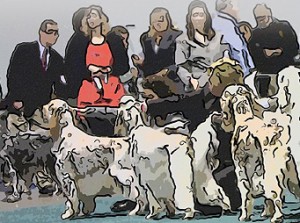Preservation Breeders – Part II – Grading Puppies
214 – September, 2016
BY PERI NORMAN
 Setters were the breed of my childhood. At ten years old, I acquired my first show quality dog. Listening and learning everything my mentors had to share, their recommendations were followed without hesitation. Although their suggestions for stud dogs came with an explanation of their reasons, their level of experience was appropriately acknowledged and advice was well-taken. Likewise, my mentors graded my litters and guided me while matching puppies to homes. Fourteen years later, I bred my first litter of Belgian Tervuren. Shortly after the pups were born, I called one of my mentors, Becky Steiner of Crestar Bel- gian Tervuren, and asked at what age she wanted to come to eval- uate the puppies. In spite of her matter of fact tone, her answer shocked me. “Two years,” she said. “You really won’t know what you have until they are at least two years old.” She did eventually agree to come evaluate the baby puppies. They might have been seven or eight weeks old at that time. I don’t really remember. However, her initial response has been food for thought over the last thirty-plus years.
Setters were the breed of my childhood. At ten years old, I acquired my first show quality dog. Listening and learning everything my mentors had to share, their recommendations were followed without hesitation. Although their suggestions for stud dogs came with an explanation of their reasons, their level of experience was appropriately acknowledged and advice was well-taken. Likewise, my mentors graded my litters and guided me while matching puppies to homes. Fourteen years later, I bred my first litter of Belgian Tervuren. Shortly after the pups were born, I called one of my mentors, Becky Steiner of Crestar Bel- gian Tervuren, and asked at what age she wanted to come to eval- uate the puppies. In spite of her matter of fact tone, her answer shocked me. “Two years,” she said. “You really won’t know what you have until they are at least two years old.” She did eventually agree to come evaluate the baby puppies. They might have been seven or eight weeks old at that time. I don’t really remember. However, her initial response has been food for thought over the last thirty-plus years.
Grading and selling puppies is a tricky business. Buyers have expectations for the things they would like to do and accomplish with the pups. As breeders, we have our own set of hopes and dreams for each individual pup. Massive amounts of research, experimentation and old-fashioned worry go into the process of car- ing for and evaluating pups, and yet an oft quoted accusation persists that breeders regularly keep the wrong one! Pat Hastings recommends that physical evaluations be done at eight weeks–plus or minus three days. Many breeders of smaller and more fragile pups keep them until 12 or even 16 weeks before making final de- cisions. Breeders with the space and ability may “grow out” pups to several months of age. Many breeders like to aptitude test puppies to assist with placing them in the best possible homes. Some performance-oriented breeders can be insistent about aptitude testing at exactly 49 days of age. This may have evolved from a mis- understanding of research on human/dog socialization done by Scott and Fuller which seemed to indicate that if a developing pup was not exposed to humans before day 49, they would never have normal dog-human relationships. How that may have morphed into day 49 being the one and only day for puppy aptitude testing, I am not sure. Certainly the approach used by Guide Dogs for the Blind, wherein testing is performed once a week on the same day over a four week period would seem more logical. With so much confusion about the process and so much riding on the decisions related to puppy evaluation and placement, it’s not surprising that we lose sleep wrestling with these decisions.
One of the challenges presented to us by the concept of preser- vation breeding is the constant integration of new information and our changing environment into how we view our roles as respon- sible breeders. How often have we responded to a friend hesitant to breed a dog because of one problem or another with, “don’t throw the baby out with the bath water”? A front slightly east-west, an ear a bit too large, or even a non-progressive juvenile cataract in an otherwise lovely specimen are really not deal breakers when we view them in terms of our shrinking numbers of purebred dogs and our gene pools teetering on the brink of collapse. How much more obtuse is it to make these sorts of judgments about baby pup- pies? When you think about it, they really are just babies with their whole future ahead of them.
Click here to read the complete article214 – September, 2016
Short URL: http://caninechronicle.com/?p=112271
Comments are closed











